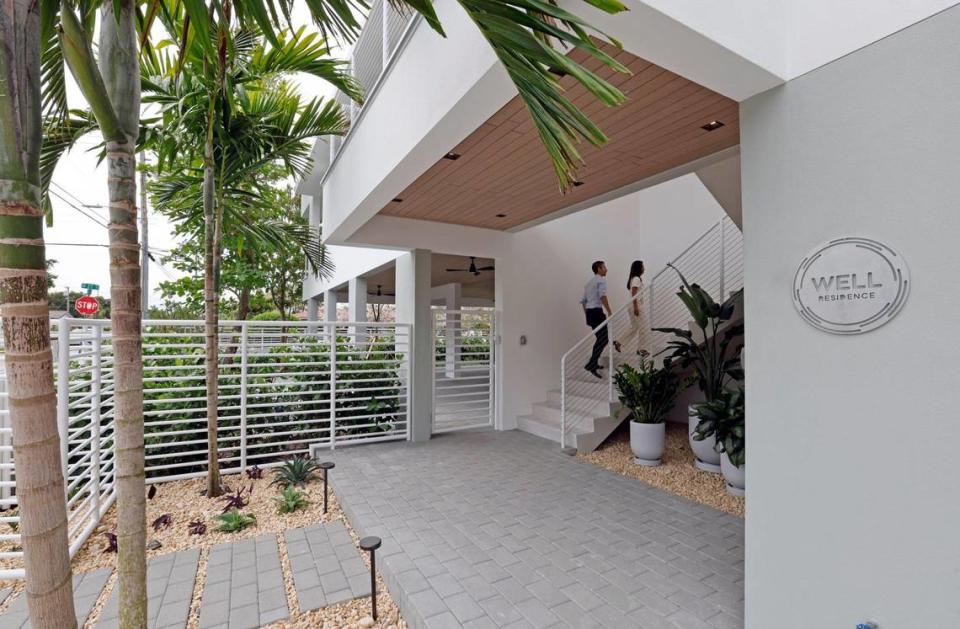Exclusive: Is this Miami house a fountain of youth? See prize-winning, health-first home
A new sugar cube house sits in a slice of Miami called Silver Bluff, a sleepy residential neighborhood between Coral Gables and Coconut Grove. Rising above land on stilts and a roof adorned with solar panels, it stands out in a neighborhood filled with houses surrounded by chain-link fences and pitched rooftops with shingles the shade of sunset orange.
Inside, the new house has extra insulation to block indoor and outdoor noise, an expansive kitchen to entice residents to cook healthy meals, and temperature controls in each bedroom to promote a better night’s sleep (the ideal is 66 to 68 degrees, health experts say).
Outside and below the house, a barbecue area has an electric grill, bathroom, and covered patio with a wood-look-alike ceiling made from rice hulls. The outdoor lounge and a two-car driveway is surrounded by groomed landscaping requiring minimal watering, including geiger trees with tangerine-colored flowers, silver buttonwood, and coontie palm, what early Groveites used to grow to boil and eat as their starch.
Before its future owners have even moved in, the three-bedroom, three-bathroom home’s sustainable, health-conscious design earned it a prestigious recognition in late March.
The 2,595-square-foot house called CM1 by architect-development firm Caplow Manzano became the first in the world to be certified by the International WELL Building Institute. The Manhattan-based organization sets the gold standard for health-conscious design. It gave its first certificate in 2014, recognizing commercial buildings.
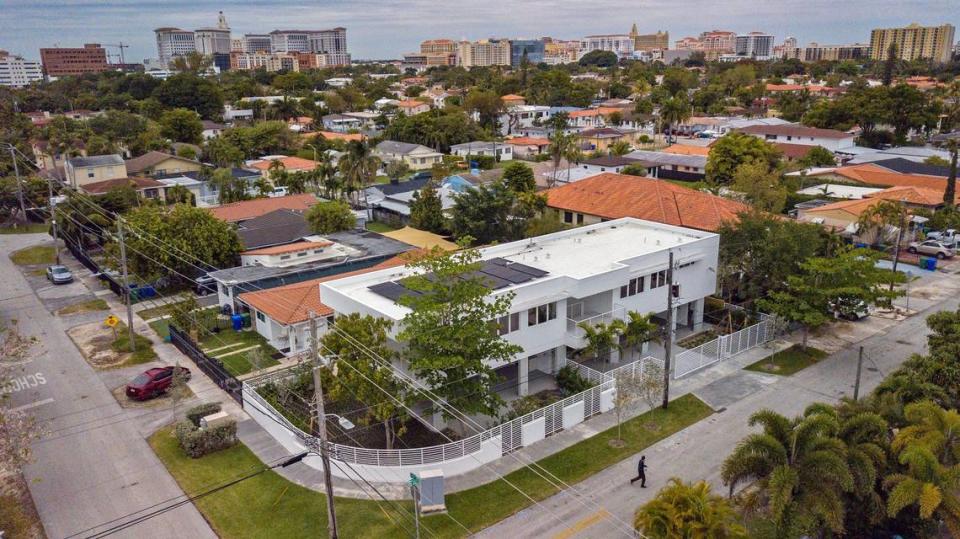
The WELL certificate and the completion of what a healthy and sustainable house can look like will likely drive demand for similar designs, said Marta Schantz, Urban Land Institute’s co-executive director of the Randall Lewis Center for Sustainability in Real Estate.
“This is not green washing. This certification is incredibly meaningful in terms of the different aspects of the building. To see this happen for a single-family home is tremendous, to see this in a residence is tremendous,” Schantz said. “The fact that the certification is available may start a wave that other building owners may say they want that, too.”
Coconut Grove-based Caplow Manzano’s first development at 2662 SW 32nd Ct. will land on the market in April for $2.6 million.
Journey to WELL certificate
In January, the International WELL Building Institute announced it added a new category focused on single-family homes. To earn a certificate, a house had to check at least 40 out of 150 points from a list of qualities meant to improve the health of the dweller.
The nearly completed CM1 earned the first certificate thanks to landing 58 points — among the highest marks among the 30,000 applicants worldwide — and for showcasing a resilient design given climate change.
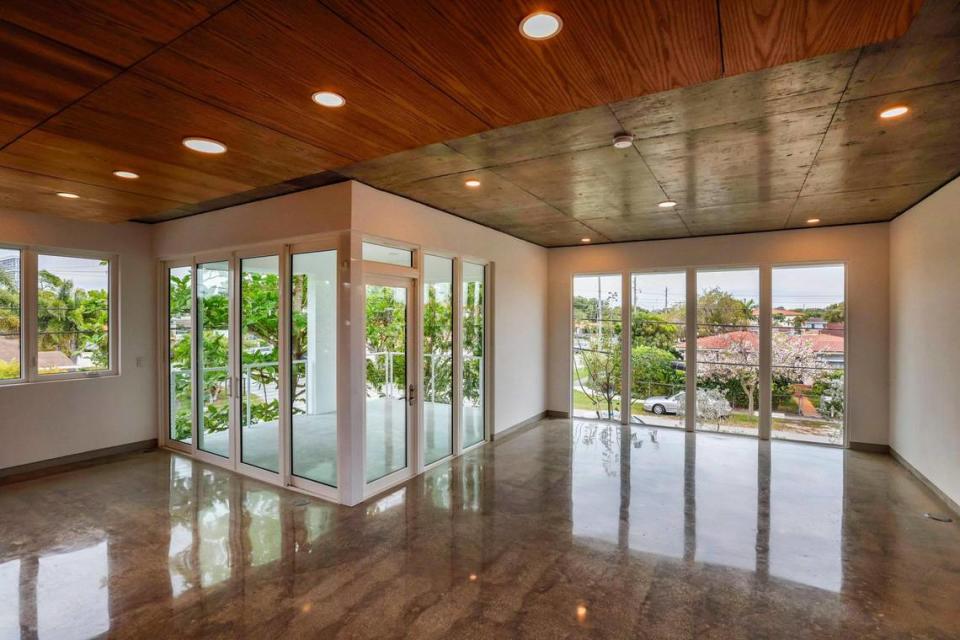
“We are thrilled to honor this home as the very first. We were incredibly impressed by the commitment of Caplow Manzano to balance goals related to climate change, sustainability and health,” said Rachel Hodgdon, WELL CEO.
“The goal for being a healthy home and resilient are inextricable,” she said. “These are homes built to survive the times. Should there be major flooding or sea levels this would be a home meant to survive.”
Sick days inspire design
The house is the brainchild of Caplow Manzano, a firm launched by co-founders Nathalie Manzano, 41, and Ted Caplow, 54. The wife-and-husband duo launched their firm in 2017 after working together at Caplow’s now-closed science nonprofit CappSci, or Caplow Applied Science. The duo’s most well-known project at the time was the Miami Science Barge, a floating, self-sustaining, solar-powered experimental ecosystem that raises fish and vegetables and functions as outdoor classroom and science lab.
The inspiration for CM1 came with the couple’s first home. After marrying in 2020, Manzano and Caplow moved into a newly constructed modern-style home in Coconut Grove where they could blend their families. Both previously married and divorced, Manzano and Caplow have a total of five kids. Within the first year, every family member had allergy-like flareups, including congestion and postnasal drip.
In search for the source of the health hiccups, Caplow ended up in one of his daughter’s rooms where he found mildew streaks around the light switches and outlet covers, indicating humid air was moving through the walls.
“That’s when it hit me that I didn’t want to share my house with all of this mysterious void space and all of these dark corners and all of these weird materials in the walls. I just want a house,” Caplow said. “We started thinking about could we take all of that out. Can we do away with the cavity wall, the drywall and just have, you know, surfaces I can look at — concrete floor, concrete ceiling, panels — that I can remove so I can get the feeling of what’s going on, peace of mind. For me that’s what tipped the balance.”
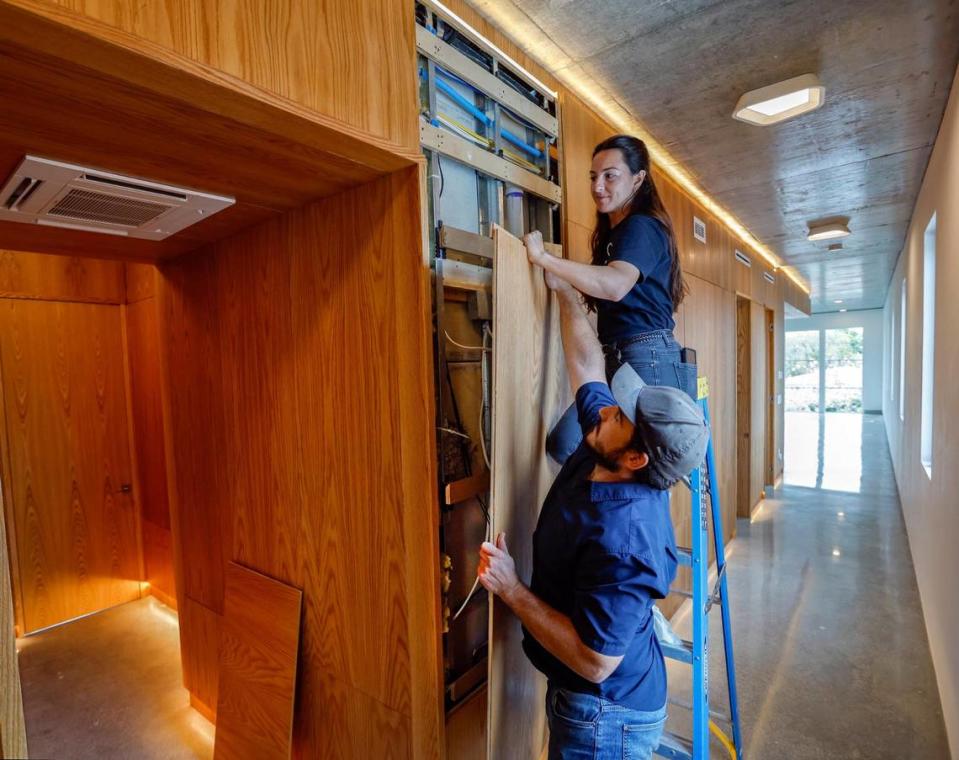
Today, the family still lives in the same Grove home, but their experiences there moved them to launch a series of residential projects abiding by their design philosophy — hypostruction — focused on eliminating void space and toxic construction materials.
They put their philosophy to the test with CM1. With the help of Robert Vick Architect and some inspiration from the historic Farnsworth House in Illinois, the team designed a house with minimal void spaces, replacing drywall with cement blocks, exposing air conditioning ducts, and placing pipes and wiring behind removable Purebond plywood panels.
“Lots of people are worried about healthy eating, organic food, the chemicals that go into their water or their food, but not really thinking about how those same kinds of chemicals are existing in their environment, which they live in, they sleep in,” Manzano said, “so thinking about that in the space was really important.”
The couple brought their vision to life in Silver Bluff, far off the water, to show that even inland residences should be thinking about floods and rising waters, Caplow said.
They bought a dilapidated house on the 6,000-square-foot site for $295,000, demolished it, and launched construction on their self-funded project in 2022. It cost them about $2 million to build. After the sale, the firm will barely make a profit, surely not enough to sustain themselves and their team of 12 employees.
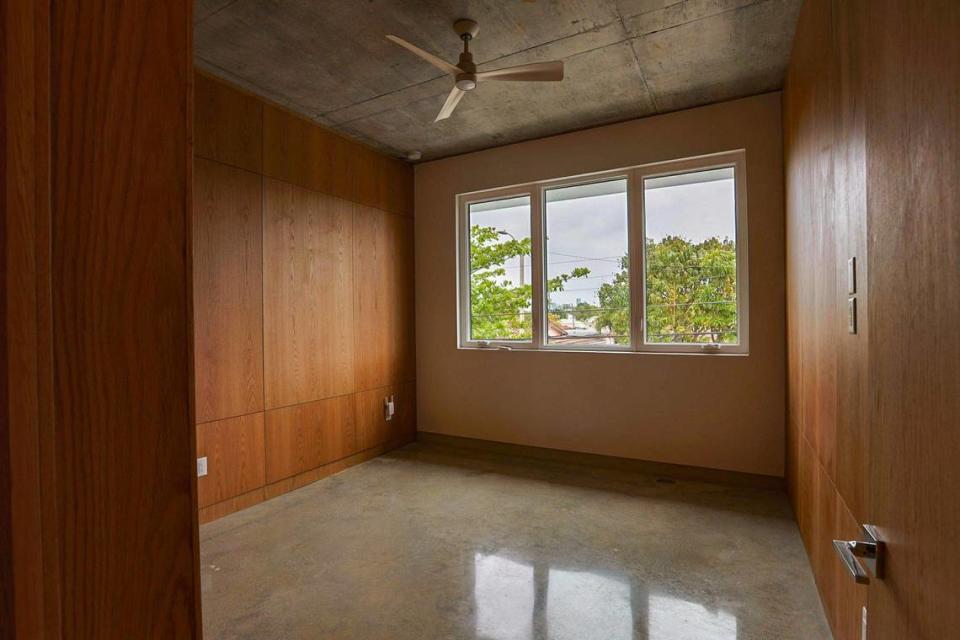
“We’re taking a long-term view on profits for our company,” Manzano said, “If you had a technology start-up, that’s how you’d view it. ...You need to build the product, get people excited, create demand, and then we’ll be able to focus on the profit.”
CM1 is one of a total of seven Caplow Manzano have in the pipeline, including one breaking ground in six months in the MiMo District and another under permitting in Coconut Grove. If the Silver Bluff house garners its listing price of $2.6 million, CM1 will be among the highest residential sales in the neighborhood. One comparable sale on a 7,150-square-foot property sold for $2.2 million a year ago. It was a 2,990-square-foot new single-story house with four bedrooms and four bathrooms at 2136 SW 25th St.
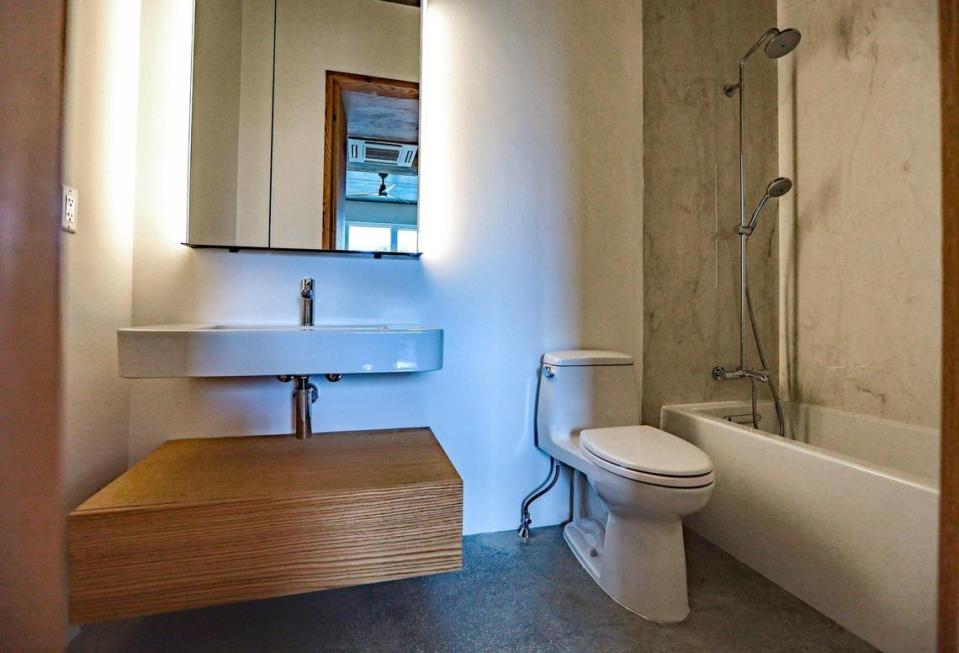
The lure of sustainable living
Already, prospective buyers looking to move to South Florida from Illinois, New York and California have booked tours to see CM1 in the next few weeks.
“Some of the highest sales in the city have been forward-thinking properties,” said Danny Hertzberg, co-listing agent with the real estate brokerage firm Jills Zeder Group. “I have seen in my career that there are properties that push the market forward.”
Sustainable designs have long been on the minds of local architects and developers, including for sought-after architects like Rene Gonzalez. But healthy homes became a priority during the pandemic.
“When we think of healthy buildings the different benefits include better health quality, different perspectives that make a difference in peoples’ lives,” said Schantz, adding COVID was an inflection point. “Before COVID, who paid attention to a building’s air quality monitors? That was a scientific thing. But that became a mainstream thing after COVID.”
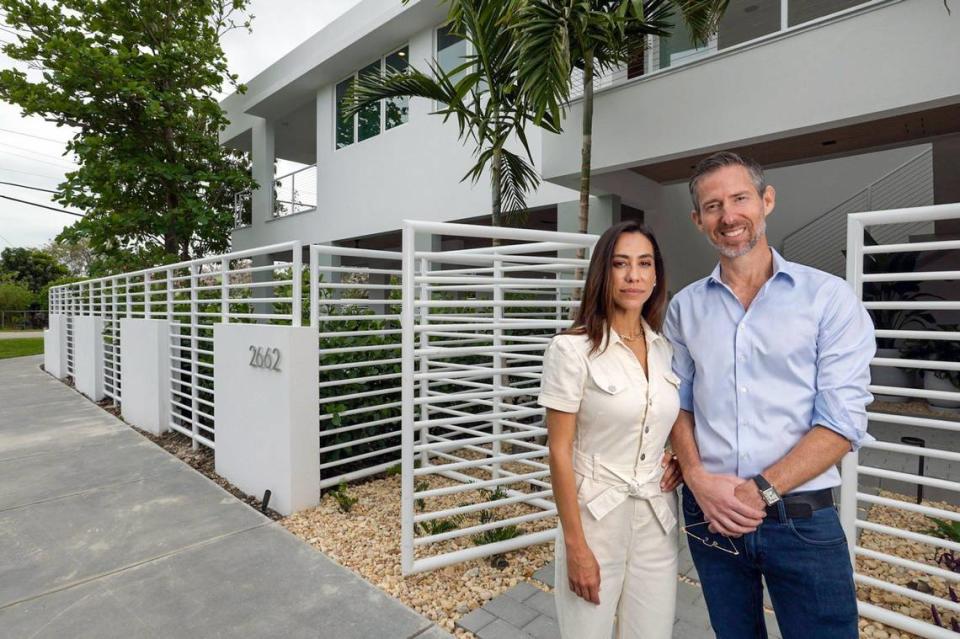
For Caplow Manzano, CM1 is only the beginning. Their other projects all aim to deliver a healthy, sustainable abode for its future residents and a model for how others may want to build in Miami-Dade.
“We were trying to think of the future of Miami and not just Miami, but homes in the urban tropics,” Manzano said. “Miami looks like a lot of what the rest of the world facing climate change looks like in terms of weather, in terms of density. We wanted to rethink the way we were building here.”
